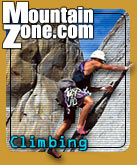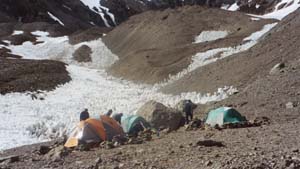
|
An Aconcagua Christmas December 9, 2003
PHASE 2: BASE CAMP & BEYOND Base Camp (12,200') itself was very amusing. Not having done an extended high altitude expedition before, I had had visions (fueled by reports from other climbers and of course, by my own 'climbing knowledge' provided by "Into Thin Air" and such, of team cook tents, showers, base camp doctors, etc.) of a bustling base of climber activity. (And of course, I found out later, these things DID exist on Aconcagua - but only on the other two main routes up the mountain). What we had, however, was one small dome base camp tent - in which we could just about squeeze all eight of us (if Ana kept half of her body outside the window) - and the biggest, most desolate, rock laden, wind-blown, depressing campsite I've ever seen. And, by now we had separated from all of the other expeditions (who traveled instead up the neighboring Relinchos Valley) and were traveling along-side only a sister Aventuras Patagonicas group, so we were sort of lonely too. In all honesty, our rest day here could not pass quickly enough. We were ready to move on and up. This was also about the time we encountered: Lesson #2: It only takes about five days of not bathing before you start dreaming about showers & five-star hotels. Having done a lot of camping, I'm well used to being dirty for days at a time. But for some reason my subconscious (and Isolina's) struggled with the thought of two-plus weeks unbathed. We amused ourselves with the daily, "What did you dream about last night?" discussion. And we decided that Handi-wipes are your friend. Except when frozen. Base Camp was also the site of some heated team discussions. You see, we had, as a team, signed up to climb Aconcagua via the Polish Glacier; one of the mountain's technical routes. On our way up the valley however, we had encountered a number of teams of climbers who reported the glacier unclimbable - and highly dangerous - in its current, wind-swept and massively icy state. Our guides now had the task of 'breaking the news to us' and trying to drive for team consensus on another route. Given what I'd heard first-hand from these climbers who'd recently attempted it, I had no interest in even considering the Polish Route. I certainly was up for a challenge, but not complete idiocy. Interestingly enough, Tom and David - our team's most experienced climbers - quickly agreed that we should abandon any Polish attempt and instead maximize our chances for a summit by traversing over and attempting our summit bid from the Normal Route's high camp. However, Gernot was adamant we not abandon what he'd signed up for and been promised. He was not taking no for an answer, so it ended up being a *very* long evening of discussion. Ultimately, we agreed, as a team, to head towards the Normal Route on the north face. G sulked a bit, but was always a good sport. Decisions made, after our rest day, it was time to begin the climb in earnest. As we ascended out of the rock pile we called Base Camp and rose above the valley floor, we scrambled over steep and loose scree slopes, and struggled to get comfortable with our packs, now loaded up with about 50lbs-plus of community gear for a carry to Camp 1. As we slowly adjusted our breathing and footsteps to the increasing altitude, we developed a fairly comfortable rhythm. That is, until we began to enter the vast fields of what I now know to be called "pentitentes"; essentially, inverted - and massive (up to eight or nine feetn) - icicles. Penitentes look truly magical and lovely from a distance - like artfully crafted ice sculptures, each and every one unique in size, shape, height, and laid it in labyrinthine fashion. However, up close and personal, they were not so lovely, as my bruised shins, bashed elbows and scraped hands and face would attest. We slipped, slid, and fell our way through them. Ironically, as I now look up the definition of pentitentes at dictionary.com, I find the following: "A member of a Roman Catholic brotherhood in parts of the Southwest, of Native American and Hispanic origin, that celebrates the Passion with rites involving fasting and self-flagellation." Sure, self-flagellation - I think I can relate to that.
Sadly, this was also the day that Lynn's earlier fight with the local vegetables became a battle with the altitude, and her dehydration led to some very scary and miserable early cerebral edema, and our guides determined she needed to return home. This is also the day that we learned the truly harsh reality of: Lesson #3: No one tells you that you really have to climb the mountain not once, but TWICE. I've always heard and understood the logic behind the "climb high, sleep low" mountaineering mantra to ensure proper acclimatization. And certainly, acclimatization is a slow and laborious process, and cannot be rushed. But I never TRULY understood that this meant that for every horrible scree slope you encountered, every river crossing, every #$&%* penitente field you ascend over, you have to have to walk back down it at the end of the day, and back up again the next. While one might optimistically say - in the-glass-is-half-full fashion - that this means you get to really know the mountain and have a chance to really 'get it right', my brain and body did not always see it that way. We grumbled and struggled, but we persevered. Camp 1 (14,500') was a comfortable camp - thankfully much more scenic than Base Camp - settled in below a steep snow field and in full view of the summit we were to climb. We spent the night here and then embarked on a massive climb to Camp 3; Mike having decided we were in great shape and could skip Camp 2. This was our steepest climb of the trip (sans Summit Day) and we gained about 3,000' vertical feet in about 6 hours, covering one endless icy snow field after another. After a small snow flurry came up, around 500 vertical feet shy of Camp 3 (17,500'), we cached our gear and headed back down to Camp 1 for the night. Again the penitentes - sigh. The following day we moved to Camp 3 and set up camp. Remnants of a crashed helicopter - whose grill we used as weight to hold one of our tents down - did little to make me feel comfortable at this altitude. The pounding headache and intense nausea I felt were not helping matters either. I asked Mike, "When do you stop feeling sick?" He said, "When you're back at sea level." I was not amused. This is also when we really knew: Lesson #4: Setting up a tent at altitude is the most difficult & frustrating thing you can imagine. By now we had come to accept that the wind patterns on Aconcagua are the opposite of those in most other places in the world. 25, 50, 100mph winds are non-stop, not just gusts. And the rare moment of calm, is beyond rare. This mountain, she does not want you to forget who is boss. You feel incredibly human, and often quite frail. Setting up our tents required an elaborate - and often two hour long - process of all five of us working on one tent. As soon as you took it out of the bag, someone hurled their body into it to keep it from blowing away, while the other four of us frantically clipped poles in and tried personally not to be carried away, kite-like, as we unfurled the fly. The really hideous part of it all was securing the guide lines of the tent beneath enough rocks to ensure nothing the mountain unleashed could release them. This generally required the collection and placement of about 25 or more pounds of rocks per guide line. And, at this altitude, wandering around hefting and ferrying huge rocks for two hours was more than enough to make at least one of us sick. If there is one thing each of us remembers from this trip less than fondly, it is putting up our tents at each camp. Camp 3 was set on a flat plain overlooking the snow-covered Andes and with an awe-inspiring view of the Summit, and we relaxed here for a day and a half. This is also where we spent Christmas day - most of us on the satellite phone, spending $5/minute to call home and talk to loved ones - and where we realized that altitude makes you feel bad in a whole other way we'd not anticipated; depression. By this time, the temperatures were so cold and the wind so fierce that unless we were hiking, we could not comfortably be outside of our tents for longer than a few minutes. This is also where the daily routine of hot tea, hot soup, pasta for every single meal (well, substitute hot cereal on the occasional morning) became more than we could bear. Eating became unwelcome. And, with the altitude wreaking havoc on our pulse rates, sleeping became difficult. Lying in your tent, staring at the ceiling for hours and listening to the wind try to tear your tent to shreds, we had to wonder just what the hell we were doing here. We began to lower our own personal expectations as well. Rather than even concerning ourselves with the summit, we now became hell bent on just surviving until 19,500' and Camp 4 - where we knew we would get to descend down an entirely different side of the mountain (after we'd climbed this side repeatedly, we were pretty well done).
Lesson #5: Aconcagua is far more beautiful & magical than the climbing world gives it credit for. Prior to booking our Polish-Glacier-route expedition, Lynn and I had read numerous books and websites warning us of the "slag heap" and "rock pile" nature of the mountain. Of a "freeway" of climbers and less than beautiful scenery or clean conditions. While later I would find our descent down the Normal Route to provide some truth to these claims, there is nothing more amazing than being high atop the Andes, under the brilliant blue Argentinean sky, staring out across Argentina, Chile and all the way to the Pacific Ocean as the sun slowly fades from view. That evening we got together for a summit prep (and pep) talk. Mike said the weather looked good for a summit bid the next day, so rather than take a rest day as expected, we'd be heading out at dawn to embark upon the final, critical ascent of the trip. He also warned us to dress warm as we slept, as the temperatures would sink well below -20. We were also advised to sleep with our water bottles, thermoses, extra clothes and gloves, and the inner liners to our plastic boots in our sleeping bags - all to ensure nothing froze or was unwearable in the morning. All very smart advice, but by the time I put all this gear in my bag I barely had room to ball up in the fetal position!
» Page 3
|
||||||||||||||||

